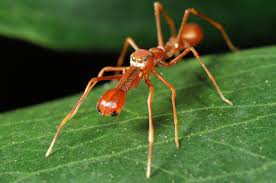In sexually dimorphic ant-mimicking spiders, it depends on the specific species which sex resembles the ant most (Cushing, 2012).
In many cases of sexually dimorphic spider myrmecomorphs, the male is more mimetic than the female, such as in Corinnidae species and the genus Castianeira, Oonopidae and Antoonops.
Such sexual dimorphism may be adaptive if the sexes are exposed to different predation pressures. The spider's mimicry of noxious ant species yields protective benefit from predators who would avoid the ants. However, the mimicry often results in being more conspicuous in their color markings than related spider species that are more camouflaged. Hence, conspicuousness can be considered a cost of Batesian mimicry. A palatable species may be evolutionary maximizing its level of protection for the smallest cost (in terms of conspicuousness). Sexual dimorphism, in which the more active sex (which, in spiders, is typically the males) evolves mimetic resemblance to noxious ants, whereas the other sex remains relatively more concealed and camouflaged behaviorally and morphologically.
Reference
Cushing, psyche (2012); 151989: 1-24


